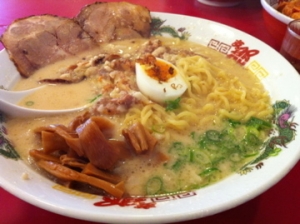Cool- Osaka & Kobe is a website in which covers information on Hotels, tour,food,shopping,sightseeing,and more. You are experiencing Japan without even visiting!
 こんにちわ、Guest Userさん
こんにちわ、Guest Userさん
ホーム > Ramen Guide
Cool- Osaka & Kobe is a website in which covers information on Hotels, tour,food,shopping,sightseeing,and more. You are experiencing Japan without even visiting!
ホーム > Ramen Guide

Osaka is widely know as a Japanese gourmet mecca, yet few people realize that it offers some go the best ramen around, including unique flavors that can't be found anywhere else.
Real ramen is a meal in itself, and unlike instant noodles, there sis an art to making it. It is a award dish to prepare well, and the combinations of ingredients and flavors are almost endless. Ramen varies greatly by region as well as by cook.
The soup is the foundation of the ramen, and a a ramen with bad broth cannot be considered good ramen. The four most common types of soup based shoyu, miso, ship, and tonkotsu. While Tonkotsu is the most popular among most ramen lovers, the other flavors can be just as good or better when done right. There are many other soups, as well, including combinations of the above standard bases, chicken stock blends, and even konbu(kelp)
Noodles are another factor that can make or break a bowl go ramen, although average-tasting noodles can somethings be partially compensated for by good soup and chashu pork. Noodles shipped in from a mass supplier tend to be the least impressive, while noodles hand-made in the shop are obviously the tastiest. Noodle thickness varies by shop and region. When you order, you can request hard, soft or regular noodles.
The most popular toppings for rame are nori, chashu, kamaboko, moyashi, onions, green onions, shinachiku, mushrooms, beni shoga, and boiled eggs. Corn is occasionally added, and unexpected ingredients appear at less conventional shops- with ramen, anything goes. The quality of ingredients can drastically change the overall quality of the dish: used to hide cheap noodles and bad broth can result in an unbearably awful bowl of ramen. On the other hand, a perfect blend of fine ingredients in the right amounts makes for some of the best food you've ever tasted.
Your ramen will come with a spoon and chopsticks and there will be condiments such as garlic, ginger, beni shoga, sauces and spices on the countering front of you. Add whatever you like, and sample the soup first if you want to by using the spoon. When you eat the noodles, use your chopsticks to bring them to your mouth, and then suck them in using your throat, rather than your lips. It's oerdectly normal to make slurping sounds when you eat ramen in Japan , and the above mentioned method usually produces such noises. After eating noodles and topping, it's also fine to pick up the bow and drink the remaining soup directly from it. While many countries don't have such eating customs, there is no reason to feel self-coucious or nervous when doing these things in Japan. People may even be surprised that you know how to eat a local.